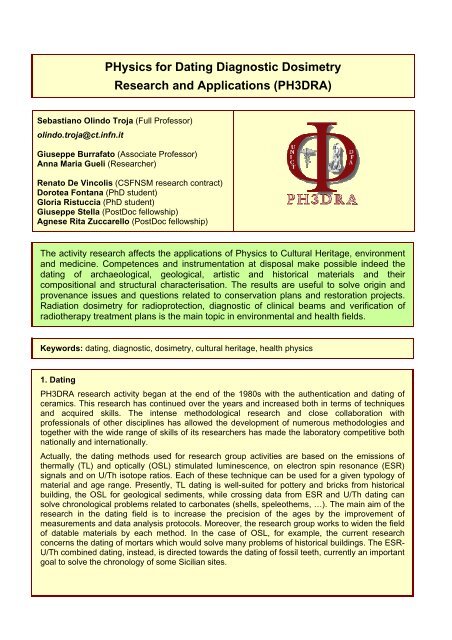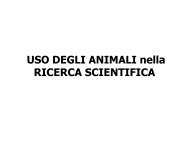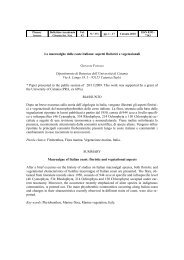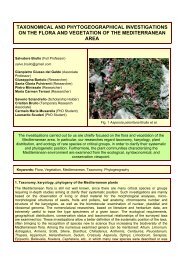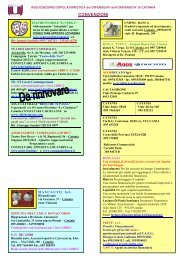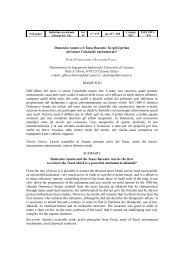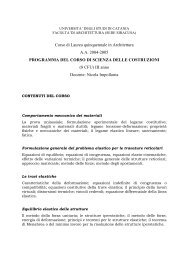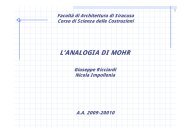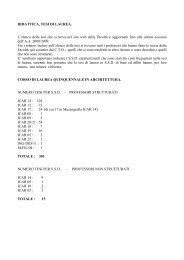PHysics for Dating Diagnostic Dosimetry Research and Applications (PH3DRA)
PHysics for Dating Diagnostic Dosimetry Research and Applications (PH3DRA)
PHysics for Dating Diagnostic Dosimetry Research and Applications (PH3DRA)
You also want an ePaper? Increase the reach of your titles
YUMPU automatically turns print PDFs into web optimized ePapers that Google loves.
<strong>PHysics</strong> <strong>for</strong> <strong>Dating</strong> <strong>Diagnostic</strong> <strong>Dosimetry</strong><br />
<strong>Research</strong> <strong>and</strong> <strong>Applications</strong> (<strong>PH3DRA</strong>)<br />
Sebastiano Olindo Troja (Full Professor)<br />
olindo.troja@ct.infn.it<br />
Giuseppe Burrafato (Associate Professor)<br />
Anna Maria Gueli (<strong>Research</strong>er)<br />
Renato De Vincolis (CSFNSM research contract)<br />
Dorotea Fontana (PhD student)<br />
Gloria Ristuccia (PhD student)<br />
Giuseppe Stella (PostDoc fellowship)<br />
Agnese Rita Zuccarello (PostDoc fellowship)<br />
The activity research affects the applications of Physics to Cultural Heritage, environment<br />
<strong>and</strong> medicine. Competences <strong>and</strong> instrumentation at disposal make possible indeed the<br />
dating of archaeological, geological, artistic <strong>and</strong> historical materials <strong>and</strong> their<br />
compositional <strong>and</strong> structural characterisation. The results are useful to solve origin <strong>and</strong><br />
provenance issues <strong>and</strong> questions related to conservation plans <strong>and</strong> restoration projects.<br />
Radiation dosimetry <strong>for</strong> radioprotection, diagnostic of clinical beams <strong>and</strong> verification of<br />
radiotherapy treatment plans is the main topic in environmental <strong>and</strong> health fields.<br />
Keywords: dating, diagnostic, dosimetry, cultural heritage, health physics<br />
1. <strong>Dating</strong><br />
<strong>PH3DRA</strong> research activity began at the end of the 1980s with the authentication <strong>and</strong> dating of<br />
ceramics. This research has continued over the years <strong>and</strong> increased both in terms of techniques<br />
<strong>and</strong> acquired skills. The intense methodological research <strong>and</strong> close collaboration with<br />
professionals of other disciplines has allowed the development of numerous methodologies <strong>and</strong><br />
together with the wide range of skills of its researchers has made the laboratory competitive both<br />
nationally <strong>and</strong> internationally.<br />
Actually, the dating methods used <strong>for</strong> research group activities are based on the emissions of<br />
thermally (TL) <strong>and</strong> optically (OSL) stimulated luminescence, on electron spin resonance (ESR)<br />
signals <strong>and</strong> on U/Th isotope ratios. Each of these technique can be used <strong>for</strong> a given typology of<br />
material <strong>and</strong> age range. Presently, TL dating is well-suited <strong>for</strong> pottery <strong>and</strong> bricks from historical<br />
building, the OSL <strong>for</strong> geological sediments, while crossing data from ESR <strong>and</strong> U/Th dating can<br />
solve chronological problems related to carbonates (shells, speleothems, …). The main aim of the<br />
research in the dating field is to increase the precision of the ages by the improvement of<br />
measurements <strong>and</strong> data analysis protocols. Moreover, the research group works to widen the field<br />
of datable materials by each method. In the case of OSL, <strong>for</strong> example, the current research<br />
concerns the dating of mortars which would solve many problems of historical buildings. The ESR-<br />
U/Th combined dating, instead, is directed towards the dating of fossil teeth, currently an important<br />
goal to solve the chronology of some Sicilian sites.
Figure 1. TL dating of building phases of San<br />
Francesco alla Collina, Paternò (CT)<br />
Figure 2. OSL dating of Pleistocene marine<br />
terraces (Capo Vaticano, Calabria)<br />
Figure 3. ESR dating: samples of speleothems from Grotta Monello (SR), Hippopotamus<br />
tooth <strong>and</strong> Cerastoderma shell <strong>for</strong> ESR-U/Th combined dating.<br />
2. <strong>Diagnostic</strong><br />
<strong>Diagnostic</strong> analysis of artefacts by non-destructive techniques play a fundamental role in the<br />
conservation plan <strong>and</strong>/or restoration project. In this field, the research activity is mainly<br />
carried out with Multispectral Imaging, Raman Spectrometry <strong>and</strong> Colorimetry methods.<br />
Multispectral Imaging (oblique light, RGB pictures, UV fluorescence <strong>and</strong> IR reflectometry)<br />
provides valuable data <strong>for</strong> frescos <strong>and</strong> paintings investigation <strong>and</strong> monitoring the state of<br />
preservation. They also permit to identify the pictorial technique <strong>and</strong> the artist’s palette,<br />
underlying drawings, second thoughts besides the detection of retouch <strong>and</strong>/or recreations.<br />
Figure 4. Copy or sketch? Example of expertise on canvas painting (left) with the same<br />
iconography of “Lamentation <strong>for</strong> Christ” (Alte Pinakothek, Munich, Germany) (right).
Raman Spectroscopy is used as a nondestructive technique <strong>for</strong> (even in situ) analysis of art <strong>and</strong><br />
cultural heritage objects, often associated with other techniques, such as XRF, SEM-EDX,<br />
colorimetry,… The spectra represent the fingerprint of examined materials, ranging from inorganic<br />
pigments to biomaterials, employed in artifacts so different as ceramics, gems, manuscripts,<br />
paintings <strong>and</strong> sculptures, where degradation products can also be assessed. <strong>PH3DRA</strong> has a wide<br />
home-made database of pigments used in paintings (ColoRaman project) while the constitution of<br />
class related to pigments used <strong>for</strong> ceramic decoration is actually in progress.<br />
Figure 5. Identification of coloured beads from Petra (Jordan)<br />
The specification of color, by spectrophotometric <strong>and</strong> spectroradiometric techniques using portable<br />
instrumentations, is carried out on polychrome artworks, such as paintings <strong>and</strong> potteries, <strong>for</strong> the<br />
identification of pigments <strong>and</strong> the planning of conservation <strong>and</strong> restoration programs. When<br />
associated to light measurements, they are also useful <strong>for</strong> evaluating the optimal conditions <strong>for</strong><br />
valorization <strong>and</strong> fruition of artworks.<br />
Figure 6. Verification of Itten theory.
3. <strong>Dosimetry</strong><br />
The research in the field of dosimetry concerns the characterization <strong>and</strong> the achievement of<br />
punctual dose measurements as well as profiles <strong>and</strong> 2D <strong>and</strong> 3D dose mapping using<br />
thermoluminescentcrystals (TLD) <strong>and</strong> Gafchromic® films.<br />
Figure 7. Clinical beam diagnostic by TLD Figure 8. Dose mapping by Gafchromic® films<br />
Collaborations <strong>and</strong> <strong>Research</strong> Grants<br />
<strong>PH3DRA</strong> is a component of GDRE European scientific coordination network “Ceramic Building<br />
Materials <strong>and</strong> New <strong>Dating</strong> Methods”, GDRE-TCA<br />
CRPAA, Centre de Recherche en Physique Appliquée à l’Archéologie, Bordeaux, France<br />
MNHN, Museum National d’Histoire Naturelle, Institut de Paléontologie Humaine, Paris, France<br />
ISPRA, Istituto Superiore per la Protezione e la Ricerca Ambientale<br />
INGV, Istituto Nazionale di Geofisica e Vulcanologia<br />
Comune di Paternò, Catania<br />
Soprintendenza per i Beni Culturali e Ambientali (Caltanissetta, Ragusa)<br />
Galleria Regionale di Palazzo Bellomo, Siracusa<br />
Istituto Statale d’Arte per la ceramica “Luigi Sturzo”, Caltagirone (CT)<br />
Selected Publications<br />
GUIBERT P., BAILIFF I. K., BLAIN S., GUELI A.M., MARTINI M., SIBILIA E., STELLA G., TROJA S.O.<br />
(2009). "Luminescence dating of architectural ceramics from an early medieval abbey: the St-Philbert<br />
intercomparison (Loire Atlantique, France)". RADIATION MEASUREMENTS, vol. 44 (5-6); p. 488-493<br />
BIANCA M., CATALANO S., DE GUIDI G., GUELI A.M., MONACO C., RISTUCCIA G.M., STELLA G.,<br />
TORTORICI G., TORTORICI L., TROJA S.O. (2010). "Luminescence chronology of Pleistocene marine<br />
terraces of Capo Vaticano peninsula (Calabria, Southern Italy)". QUATERNARY INTERNATIONAL, vol. 232;<br />
p. 114-121<br />
BAHAIN J.J., BURRAFATO G., FALGUÈRES C., GUELI A.M., STELLA G., TROJA S.O., ZUCCARELLO A.R.<br />
(2010). "ESR <strong>and</strong> U/Th dating methodologies applied to carbonates from Southern Italy". In: I. TURBANTI<br />
MEMMI ed. Proceedings of 37th International Symposium on Archaeometry. p. 481-488, Berlin Heidelberg:<br />
Springer-Verlag<br />
FARINELLA G.M., GALLO G., GUELI A.M., STANCO F. (2009). "Automatic Recognition of Color Pigments<br />
from Raman Spectrum Analysis". COMMUNICATIONS TO SIMAI CONGRESS, vol. 3; p. 211-220<br />
GUELI A.M., DUBERNET S., BURRAFATO G., CHAPOULIE R., RISTUCCIA G.M., SACHET I., STELLA G.,<br />
TROJA S.O., ZUCCARELLO A.R. (2010). "Analysis of coloured beads from Petra (Jordan)".<br />
SANTARCANGELO DI ROMAGNA (RN): Maggioli Editore, Quaderni di Ottica e Fotonica, vol. 19, p. 195-202


